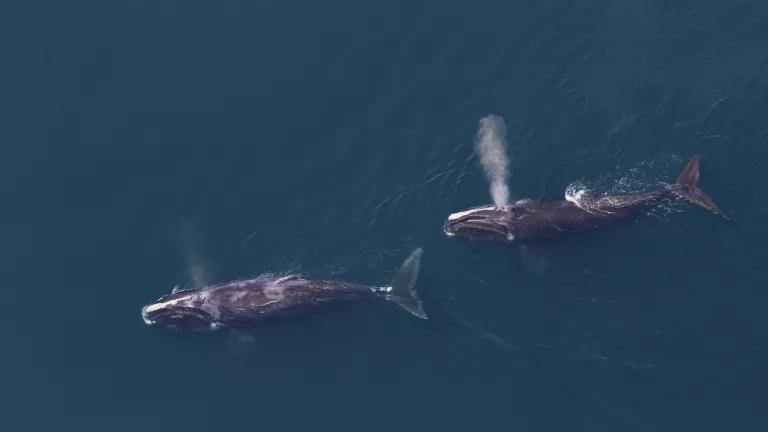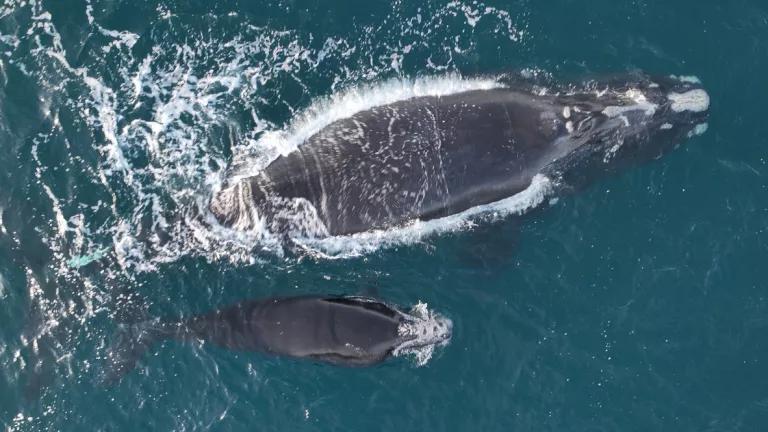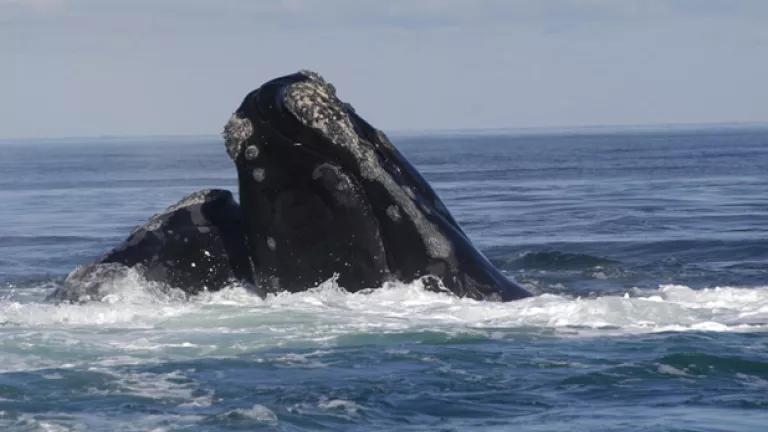Science Confirms Southern New England Waters Are of Renewed Importance for Right Whales
Numbers of critically endangered right whales have significantly increased off of southern New England, which has implications for species management, including for fisheries, the maritime industry, and the emerging offshore wind energy sector.

Right whales are spending more time feeding in the waters off Southern New England than in the recent past.
Numbers of critically endangered right whales have significantly increased during the winter and spring in the waters off Southern New England—according to a new scientific study. The findings have implications for species management, including for fisheries, the maritime industry, and the emerging offshore wind energy sector.
North Atlantic right whales used to follow a predictable migratory pattern as they travelled between calving grounds in the warm waters off the southeast United States and cool nutrient-rich feeding areas in Cape Cod Bay and the Gulf of Maine, as well as further north in Atlantic Canada. However, warming ocean temperatures have caused shifts in the distribution of the North Atlantic right whale’s main prey, a zooplankton called Calanus finmarchicus. Right whales are following their food into new areas or staying longer in some feeding areas than they did in the recent past.

Survey effort (black lines) and right whale sightings (red circles) during (b) 2011-2012, (c) 2013-2015, (d) 2017-2019. White shading represents MA/RI wind energy lease areas.
A new scientific study, led by the New England Aquarium and published in the journal Nature Scientific Reports last week, analyzed data collected during systematic aerial surveys conducted within the offshore wind energy development area off southern Massachusetts, as well as from across the broader region. The resulting multi-year data set enabled the scientist team to compare data from two different time periods (2013-2015 and 2017-2019) to assess trends in abundance of right whales in the region during winter and spring.
The study confirmed a growing understanding that the number of right whales using habitat off Southern New England—known to be an historic whaling ground—in the winter and spring significantly increased between 2013 and 2019. Right whales were also detected during every season surveyed from 2017 to 2019. Confirmed year-round detection is unique among major right whale habitats. During these surveys, the scientists observed right whales feeding and groups of whales socializing at the water’s surface. The authors conclude that their results, when interpreted alongside previous studies, “suggest that [Southern New England] represents an increasingly important habitat for the declining right whale population.”
Fewer than 340 right whales remain, and the species is continuing to decline rapidly. When the species’ distribution started to shift a little over a decade ago, few management measures were in place to protect them in the habitat areas they were moving into or spending more time in. Elevated numbers of entanglements in fishing gear and vessel strikes ensued and, in 2017, the National Marine Fisheries Service declared that the species was experiencing an unusual mortality event. Deaths and sublethal impacts from entanglements and vessel strikes, as well as other stressors such as ocean noise, malnutrition, and climate change impacts, continue to pose a serious threat to the species’ survival.

Entangled North Atlantic right whale mom "Snow cone" gave birth to her calf while entangled. The ropes put the safety of her calf at constant risk.
The waters offshore Southern New England should be a top priority for management actions to reduce the risks of entanglement and vessel strike. Solutions like ropeless fishing systems, which virtually eliminate the risk of entanglement while helping fishermen maintain their livelihoods, and a safer 10-knot speed limit for all vessels would significantly reduce these deadly risks.
NRDC is advocating for comprehensive solutions for right whale recovery, including for sufficiently protective vessel speed rules for the shipping and maritime industries, as well as other ocean users, and advancing ropeless fishing systems to large-scale commercial use. We are also encouraging strong mitigation and monitoring requirements as offshore wind takes off along American shores.
In the waters off Southern New England, where steel for the first commercial-scale offshore wind projects in the United States is expected to hit the water in 2023, advancing offshore wind in a manner that minimizes potential risks to right whales must be a top priority for regulators and developers.

Strong mitigation and monitoring measures are required to protect right whales and other marine life as offshore wind development takes off in the waters off Southern New England.
Monitoring endangered and vulnerable species and their habitats is of critical importance. The New England Aquarium’s study was made possible by multi-year standardized aerial survey effort—a relatively rare occurrence in marine science. We must support the Regional Wildlife Science Collaborative for Offshore Wind and others in their efforts to undertake smart research, including by ensuring they receive sustained funding, if we are to continue to responsibly develop and operate offshore.




